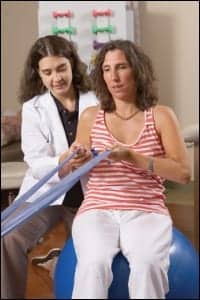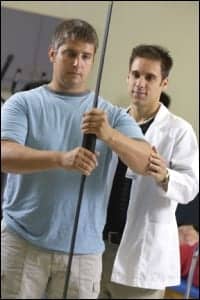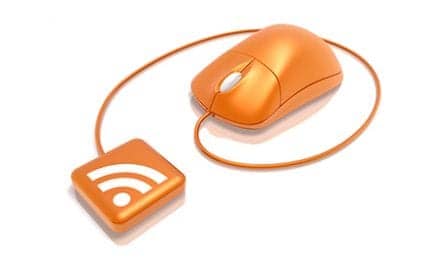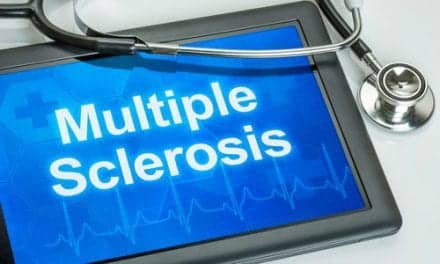
Melissa Leaser, PT, of Good Shepherd Physical Therapy-Stroudsburg, Pa, focuses on strengthening patient Diana Modugno’s scapular musculature to improve posture.
According to a report released in 2009 by the Census Bureau, Baby Boomer statistics show that there are 78 million members of this generation living in the United States. In addition, 50% of all visits to doctors in 2001 were made by Baby Boomers.1 This is a generation that may still be very active, performing many of the same activities they did in their younger years, or they may be under the direction of a physician who has told them to start exercising for health reasons. In many cases, these active older adults still feel they are able to do the same activities they performed at a younger age, but their bodies may now have a different idea. All of this adds up to potential new injuries for Boomers.
There are several factors that put older adults at an increased risk for injury as they age. First, after the age of 30, muscle mass begins to decline. This process is called sarcopenia, and it can make the muscles weaker and more prone to tendonitis, strain, or possibly even a tear.2 In addition, bone mass also begins to decline, which increases the likelihood of fractures, including stress fractures, which are common in this age group. Ligaments and tendons lose their elasticity and have a greater risk of becoming overstretched.3 Lastly, degenerative joint disease, which may even start at an earlier age, becomes more problematic among this age group. However, strength training and flexibility exercises can significantly help to slow down the progression of this condition.
COMMON INJURIES AND ASSESSMENT
Activities such as walking, golfing, tennis, bowling, and even running are performed regularly among the Boomers. The most common injury experienced with this age group is the chronic overuse type. Rotator cuff tendonitis is common in older athletes who partake in sports such as softball, tennis, or golf, which require repetitive overhead activities. Likewise, common injuries of the lower extremities include pain from osteoarthritis and meniscus tears, which usually occur from jogging, walking, and other activities with high ground reaction forces. Tendonitis in the lower extremity is also common due to weakness and tightness that may develop over time from lack of stretching and strength training.
There is a lot that physical therapists can do to rehabilitate Boomers with injuries to a point where they can return to their activities. Treatment for these “weekend warriors” is based on a thorough examination. According to a study published in the October 2005 issue of the Journal of the American Academy of Orthopaedic Surgeons, proper diagnosis and treatment of musculoskeletal problems in aging athletes will help active older adults maintain function and safely return to sports via individually tailored exercise programs.3 Assessing strength, flexibility, and biomechanical factors is an essential component in developing a treatment plan.
For the lower extremity, quadriceps strength is a good starting point for an assessment because of the importance of this muscle group for so many power activities, such as jumping and running. However, assessing hip and hamstring strength is also necessary, as those muscles are key synergists and antagonists to the quadriceps for many activities. When assessing the upper extremities, keep in mind that most older athletes have strong deltoid musculature, but weak rotator cuff and scapula stabilizers, making this patient population more prone to injuries such as rotator cuff tendonitis, or possibly a tear. Finding these muscle imbalances is essential to develop a sound treatment strategy.

For more information about addressing the needs of Baby Boomers, read “Blazing the Trail into Boomer Wellness and Prevention” and “Stay-at-Home Solutions for Seniors” from previous issues.
While assessing flexibility, not only look at muscular length and joint range of motion (ROM), but also assess capsular mobility. Typically, as people age, they start to see a decline in flexibility, which could lead to the likelihood of strain/sprains, spinal pain, and increased compressive forces in the joint.
In addition to flexibility, assessing the mechanics of the activity that caused the pain is important. Modifying the technique, using correct form, or recommending different equipment can help to eliminate the pain and prevent it from recurring.
Lastly, check to see if the patient could benefit from an orthotic. Over time, the arches of the feet may begin to flatten, thereby potentially leading to several of the lower extremity overuse injuries.
REHAB SOLUTIONS
Treatment to return these Boomer athletes to their previous activities involves a multifaceted approach. Education is the first step in any treatment plan. These patients are usually adamant about their exercise. Many times they will continue to work through the injury, which will only make it worse over time. Stressing the importance of rest, or at least reducing the intensity of the activity, is a necessary step on the road to proper recovery. In some cases, rest will not be enough and the patient may have to abandon the activity all together. In this case, cross-training or performing an activity that stresses the muscular and cardiovascular system without affecting the injured area is a recommended approach. For example, activities like jogging or walking can cause an increase in knee arthritis pain. So, allowing the athlete to perform low impact activities such as elliptical training, bicycling, or aquatic exercise can still have positive physiological benefits for the patient, without the negative ground reaction forces and pain.

Physical therapist Tom Zeiser works with patient Stephen Koutch on static training exercises to improve scapular and rotator cuff musculature endurance.
For acute injuries, treatment focuses on reducing the inflammation. Modalities, including iontophoresis and electrical stimulation, and cold packs can be beneficial in reducing the early inflammatory effects. Also, during the evaluation, if any flexibility issues are noted, it is important to address them. Focusing on calf, hamstring, quadriceps, and hip musculature is essential to treating many lower extremity injuries, such as Achilles tendonitis, hamstring strain, and hip tendonitis. To improve flexibility, a variety of standing and mat stretches can be utilized to focus on the problem areas. The stretches should be performed for a total end range time of 2 to 3 minutes twice daily after proper warm-up. Once the acute inflammation subsides, ultrasound, electrical stimulation, massage, hot packs, or general warm-up can be used to stimulate blood flow to the injured area. These modalities either can warm the tissue for a safer, more effective stretch, or stimulate blood flow to the area to promote tissue healing if the injury develops into more of a chronic tendonosis.
STRENGTHENING ACTIVITIES
Once the acute pain is reduced, it is time to begin light strengthening exercises. This may begin with isometrics and progress to isotonic exercises or bands. The program can progress as needed with proprioception, dynamic stability, and core training. Specifically, when exercising the quadriceps, it is preferential to carry out these exercises in a closed chain setting that mimics their activities, also known as specificity to exercise. Executing the exercises in this manner correlates to the patient’s activity, thereby improving performance.2 For the overhead athletes with shoulder tendonitis, focus on strengthening posterior shoulder musculature, including the rotator cuff and scapula stabilizers/rotators, and work on proprioception/dynamic stability of the shoulder musculature to prevent further impingement and promote healing.4 Lastly, a weak core could predispose the athletes to injury and could also hinder performance. Therefore, performing core exercises is also a necessary component.
PATIENT BUY-IN
As noted, education during treatment and at discharge is the final component. The patient should be taught dynamic warm-up strategies. These are performed for 5 to 10 minutes and are specific to the individual’s activity. The dynamic stretches are ideal to perform before the activity, since research has shown that static stretching before an activity can decrease force production, putting the athlete at risk of injury.2 Also, education on continued compliance with a home exercise program and review of activity modification are key components to prevent the injury from returning.
With proper treatment and education, Boomer athletes can still enjoy a very active and fun lifestyle. It may just take some modification to their existing program and more focus on flexibility and strengthening for these athletes to still have the ability to perform the activities they love for many more years to come. RM
Tom Zeiser, PT, DPT, CSCS, is site manager at Good Shepherd Physical Therapy-Blandon in Blandon, Pa. Zeiser has practiced physical therapy for 7 years, and has treated a variety of orthopedic and sport conditions. He has treated athletes who range in age from preteens to seniors, including elite collegiate and high school competitors. For more information, contact
References
- Love to Know. [removed]seniors.lovetoknow.com/Baby_Boomer_Statistics[/removed] . Accessed June 21, 2010.
- Baechle T, Earle R. Essentials of Strength Training and Conditioning. 3rd ed. Champaign, Ill: Human Kinetics; 2008.
- America’s Seniors. todaysseniorsnetwork.com/regimen_needed.htm. Accessed June 19, 2010.
- Andrews J, Reinold M, Wilk K. The Athlete’s Shoulder. 2nd ed. Philadelphia: Churchill Livingstone; 2009.





